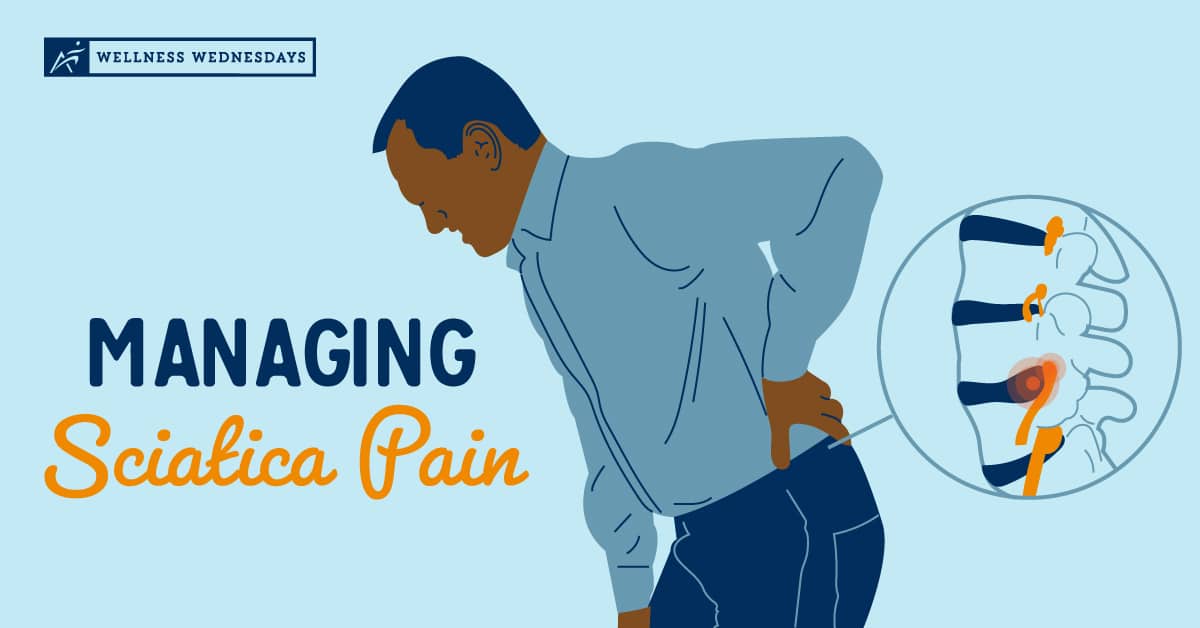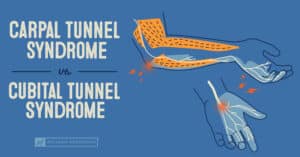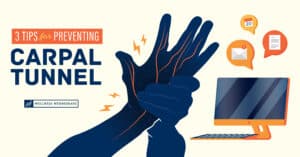The sciatic nerve is the largest in the nervous system. Its circumference is about the size of your pinky finger, and it’s responsible for connecting the spinal cord to the leg and foot muscles. Any pressure on the sciatic nerve can cause a radiating pain, called sciatica, to appear throughout these regions of the lower body.
Sciatica itself is a symptom, not a diagnosis, and there are many conditions or factors that can cause sciatic-like pain. Continue reading below to learn more about sciatica, and how Airrosti can help!
Common Causes of Sciatica
Herniated Disc
The spine is comprised of individual bones called vertebrae that stack vertically, creating a frame for the body to stand upright. Between these stacks of vertebrae are rubbery cushions called “discs” that hold the spine together and provide mobility. If there is a disc herniation, a tear in one of the discs that allows the soft center to push through, this rupture can irritate nearby nerves. A herniated disc in the lumbar region of the spine can irritate the sciatic nerve, causing sciatica.
Piriformis Syndrome & Muscle Strain
The piriformis muscle is a small muscle behind the gluteus maximus. Near the sciatic nerve, the piriformis can sometimes spasm and compress the sciatic nerve. Although Piriformis Syndrome isn’t as common as a herniated disc, it can still hinder your mobility and cause sciatic pain.
The inflammation from a muscle strain in the lower back or gluteus muscles can put pressure on the sciatic nerve roots, causing tingling and numbness.
Pregnancy
Sciatica can also develop as pregnancy-related pain, particularly with pain in the lower back and upper thighs. Weight gain and fluid retention, which increase dramatically in the third trimester of pregnancy, can put pressure on the sciatic nerve. This pain typically worsens with prolonged sitting or standing. Sciatic pain associated with pregnancy is often alleviated with conservative care but may take several months to resolve.
Other Related Factors
Age plays a major factor in changes to our bones, especially our spine. As we age, the discs in our spine can degenerate and suffer from wear and tear and can trigger sciatica. In addition, you may even develop bone spurs, which are small overgrowths on your bones, that could play a factor.
Prolonged periods of sitting, whether for your job or leisure could also increase your risk of sciatica. Certain conditions or diseases, like diabetes, could affect your nerves as well as possibly damage them. This could also cause sciatica.
What Are the Symptoms?
Because sciatica affects the sciatic nerve, most symptoms are going to be in the low back, hip, and on the outside of the leg. Below are a few symptoms associated with sciatica.
- Sharp lower back pain.
- Pain that originates in the lower back or hip and radiates along the sciatic nerve and throughout the back of the leg.
- Constant or shooting pain in one side of the buttock or leg.
- Pain when sitting or twisting and bending.
- Leg weakness or numbness, that could cause possible difficulty walking.
- Possible incontinence.
Tips To Relieve Sciatic Pain
Most cases of sciatic pain are mild and can resolve themselves with time and rest. However, not everyone can take the time out of their busy lives to wait for the pain to go away. Here are a few more active measures you can take to help relieve your sciatic pain and prevent it from resurfacing.
Sit Less, Move More
We all know that prolonged sitting is unhealthy, but did you know that sitting for too long can also be a risk factor for sciatica? There are various ways you can start building active habits to avoid sitting for long periods of time.
- Practice proper posture when sitting.
- Take breaks often throughout the day.
- Try working in small exercises or stretches into your daily schedule.
If you are currently experiencing sciatic pain and need some immediate relief, try the exercises below. Keeping your body moving and active can help reduce pain, as well as strengthen your back.
*Disclaimer: Always consult with your doctor before starting any exercise program. If you experience any numbness, tingling, or reproduction of your symptoms, please contact your doctor.
Still Struggling with Sciatica?
Without proper diagnosis or treatment, your sciatic pain may worsen or become chronic. At Airrosti, our providers aim to diagnose and treat your sciatic pain at the source. With a customized treatment plan and active rehab exercises, your Provider can help you get back to enjoying your life, as well as getting your body physically active again!
Call us at (800) 404-6050 or schedule an appointment online today and kick your sciatic pain to the curb.
View our medical disclaimer here.










